Part 2
Now that you’ve
decided where to position your design center and target it to meet the
needs of specific customers types, it’s time to decide what to put in it.
The first part of this two-part series, featured in the July/August edition
(www.furninfo.com/authors/jennifer-magee/86), explained why creating a prominent and well-configured Design Center
attracts customers, especially those who value design or feel they need help
to make better purchasing decisions. Also covered were:
- Placement strategies.
-
Placement strategies. Ways to create design center areas that complement
the sales process.
- How to think about issues of exclusivity and accessibility.
-
Good, better and best approaches to balance the needs of different
customer types.Examples of how retailers such as Pottery Barn, Living
Spaces, Interiors Home, La-Z-Boy, Furnitureland South, and others have
approached design center projects.
-
Examples of how retailers such as Pottery Barn, Living Spaces, Interiors
Home, La-Z-Boy, Furnitureland South, and others have approached design
center projects.
This installment expands the discussion, taking a closer look at the
amenities and technologies retailers should consider including in design
areas to better engage home furnishings shoppers.
Amenities & Special Features
Consider outfitting Design Centers with amenities and special features that
make customers feel comfortable and empowered.
Snacks: Having a coffee bar or water station with snacks
increases the time customers work with in-store designers.
Screens: Install large-scale digital screens for
presentations. In private room settings, these can be easily mounted on an
adjacent wall surface. In an open Design Center setting, interactive digital
screens can be integrated into meeting tables.
Staging Areas: Some retailers designate a portion of their
Design Center as a staging area. This space can be used to make physical
presentations of furniture or decor displayed on a stage or series of
platforms. It may also include:
- A hanging bar from which to drape rugs or curtains.
- Pull-down screens that can provide a colored backdrop or image.
-
Specialty track lighting that can be adjusted to create a particular mood.
- Cork or MDF boards for pinning up samples and images.
A staging space may also be used by interior designers to showcase
accessorized furniture groupings to help customers fully visualize the
design of their home.
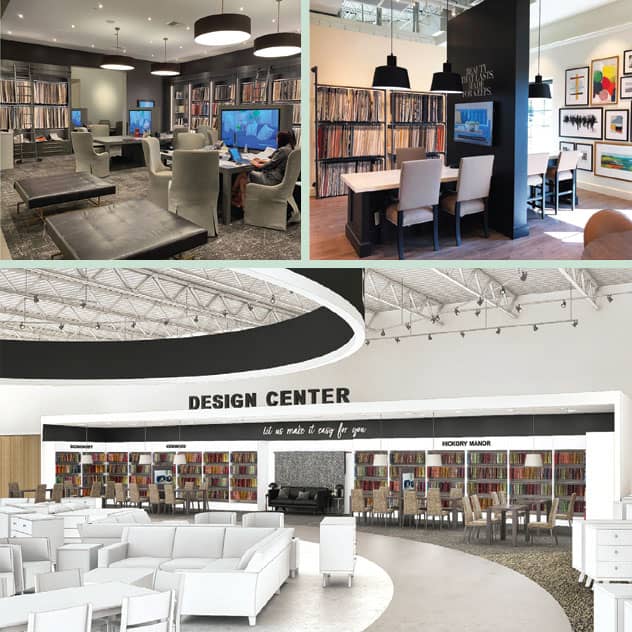
MATHIS DESIGN STUDIO: Mathis Design Studio (top left)
provides large, comfortable tables with integrated dual-sided digital
screens where customers can sit with a designer.
ETHAN ALLEN: Ethan Allen (top right) allows customers
to use touch screens to browse a full product portfolio while also
accessing fabric and wood samples.
FURNITURE MALL OF MISSOURI: For its new Kansas City
store, Furniture Mall of Missouri added multiple Design Centers,
including one for high-end customers (bottom) that includes a central
staging area.
Lighting
Lighting is an essential part of the Design Center experience. Providing
natural light through a skylight or adjacent windows can help customers see
the actual colors and textures of fabric swatches. Installing artificial
skylights and windows that mimic natural light is often a more
cost-effective and flexible alternative to natural light. Some retailers
have also installed “light bars” to showcase different types of lighting
(incandescent, LED, fluorescent) at different color temperatures, so
customers can evaluate fabric samples under the type of illumination they
have in their homes.
It is best to use true-color light bulbs when possible so that colors and
fabrics are seen true-to-life. It is also important that fabric and finish
samples are lit properly from an angle above. Track light should be set four
to six feet off the face of samples and angled 30 to 60 degrees to fully
wash light down the face of vertical displays.
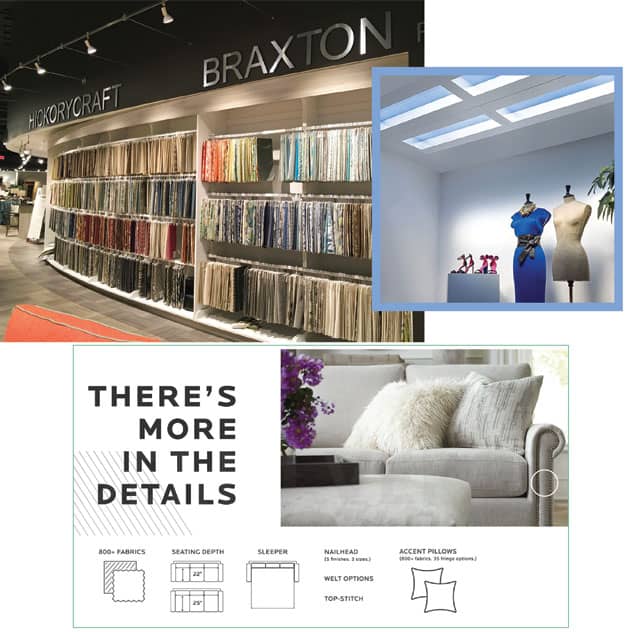
NATURAL LIGHT: Better engineering and light
simulation has made artificial skylights and windows a viable
alternative to natural light. CoeLux Artificial Skylights from
Lightology shown top right.
JOHNNY JANOSIK: Johnny Janosik’s centrally-located,
oval-shaped Design Center features each brand’s name above fabric
samples, making the selections (above left) easy to browse.
BASSETT: In addition to offering physical
customization displays in-store, Bassett does an excellent job of
walking customers through custom options (bottom) online.
Displays
Most Design Centers feature an upholstery/ fabric customization story. It is
important to present fabric swatches in a prominent and easy-to-browse way.
The most common approach is to suspend fabric swatches on hangers hung on
rods in open cabinets or off walls. Ideally, rods should be adjustable so
both shorter and longer swatches can be easily displayed. It also helps to
waterfall fabrics from the upper back to the lower front of the display to
accommodate more samples and catch light from the track above. The most
efficient way to sell customized fabrics is to group them by brand.
Leather samples are best displayed as large-scale cowhides hung on walls
from hooks. Sofa or chair customization options such as arm and leg styles,
trim and cushions should not be overlooked. Present all of the variations in
a clear and precise way. The best approach is to display physical samples
for each option. For example, Bassett Furniture offers an in-store display
that includes custom options for legs, trim, arms and cushions. Sample sofas
are elevated on platforms. They hang their custom fabrics in cabinets. The
same kind of customization options are also featured online. These kinds of
displays help tell stories that are relevant to each brand.
Everything for the Home
Many furniture retailers have added customizable options for dining tables,
chairs, counter stools, bedrooms and Amish furniture. Customers can select
wood types, door styles and hardware.
We are also seeing an increase in retailers offering Design Center add-ons
such as:
-
Custom draperies, window coverings and blinds, like those from Hunter
Douglas.
- Flooring options such as luxury vinyl tile, hardwood, and tile.
- Custom kitchens, bathrooms, and closets.
-
Customized sleep options that pair mattresses with adjustable bases to
meet clients’ specific needs.
Retailers will lose sales if they don’t make an effort at multiple
touchpoints to let customers know that they provide these add-on options.
“Some retailers have installed ‘light bars’ that showcase different types of
lighting so customers can see fabric samples under the type of lighting they
have in their home.”
As Design Center concepts continue to expand, furniture retailers have found
that strategically moving certain merchandise categories to adjacent areas
is a good idea. Rugs, for example, work extremely well next to these areas,
leading to easy add-on sales. Accent chairs and tables tend to perform
better near Design Centers, as do accessories, artwork and other
marketplace-type items. Consider putting up wall displays of lamps, pillows
and accents directly adjacent to or within Design Centers to inspire
shoppers and help them create complete design looks.
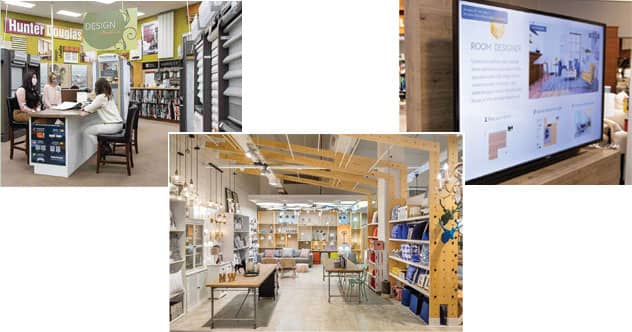
3D PLANNING SOFTWARE: Allowing customers to use 3D
Room Planning software has become a popular part of the Design Center
experience (pictured to right).
SCHEELS HOME & HARDWARE: Scheels Home & Hardware
offers a Design Studio that features everything from Hunter Douglas
window treatments to Sherman-Williams paint finishes. They even have a
botanical area for plants & florals (top left).
BETILI: Betili, the largest home design chain in
Israel, launched a new store concept (bottom) in which accessories
such as lighting, pillows, and decor have a more prominent role in the
store.
Current Trends
Style Centers and Stylists: During COVID, it was common for
retailers to have difficulty fulfilling custom orders in a reasonable amount
of time. This forced some to drop customized products from line-ups in favor
of items that could be stocked and sold off the floor.
To continue to cater to customers looking for custom options, stores
improvised. Many displayed large numbers of accent pillows on a pillow wall
to make any sofa “custom.” Some provided “custom” hardware options for
dining and bedroom groups. Others emphasized accessorizing with accent
lamps, decor and rugs to give shoppers the feeling of customization.
Instead of referring to designers as interior designers or interior
decorators, the descriptions “stylists” and “style experts” emerged. Design
Centers became “Style Centers.” Retailers moved away from the promise of
“customization” and towards “interior decoration” and “styling services.”
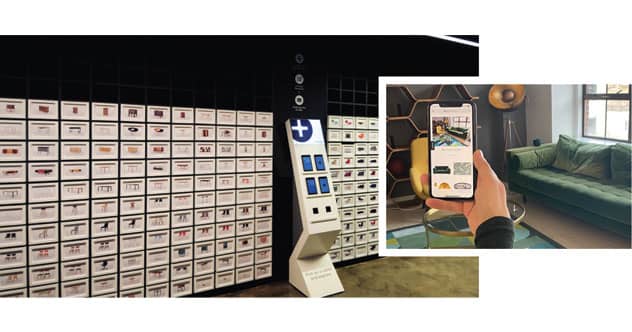 VISUALIZATION TOOLS: London-based
Made.com provides its customers with
advanced, online 3D visualization tools (above right). In-store, they
offer full-scale digital projections along with a sample wall (above
left) of 600 product lines.
VISUALIZATION TOOLS: London-based
Made.com provides its customers with
advanced, online 3D visualization tools (above right). In-store, they
offer full-scale digital projections along with a sample wall (above
left) of 600 product lines.
“Customers don’t want to walk back and forth between a sofa they like and
fabric sample options displayed in a centrally located Design Center farther
away. The solution is to create customization outposts.”
Customization Outposts: Customers often resist walking back
and forth between a sofa they like and fabric sample options displayed at a
centrally located Design Center farther away. One solution is to create
customization outposts that bring fabric options closer to furniture
displays.
Interiors Home, for example, is opening a new 35,000-square-foot store in
York, Pennsylvania, which features three separate “Style Centers,” one for
each price point (Good, Better & Best). These areas are augmented by a large
Design Center located towards the rear of the store where customers can sit
down with designers and work through ideas. Included are additional options
like window treatments, rugs, and casegood hardware.
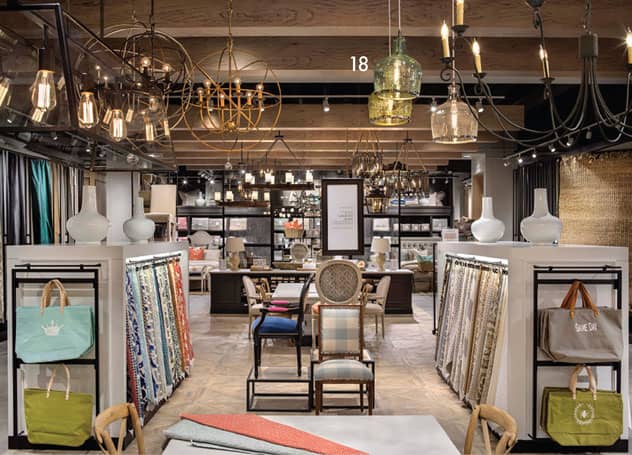 BALLARD DESIGNS created an immersive experience where
furniture vignettes along with decor, lighting, rugs, and more are
presented around a central Design Solutions workshop that includes a
personalization station for monogramming accessories.
BALLARD DESIGNS created an immersive experience where
furniture vignettes along with decor, lighting, rugs, and more are
presented around a central Design Solutions workshop that includes a
personalization station for monogramming accessories.
Modular and Movable Displays: Retailers are also moving
towards modular and portable fabric displays. These offer limited selections
of custom fabric options displayed on carts that can easily be wheeled
around. Limiting fabric selection to best-sellers in mostly neutral colors
and textures at mid-level price points has the advantage of not overwhelming
customers. If a customer does not find a suitable fabric on the cart, they
can be led to the larger Design Center that features all the fabric
selections (including repeats of those on the carts). This arrangement keeps
sales associates from having to shuffle customers back and forth and,
therefore, losing sales.
Technology: In addition to physical displays, technology
should be fully integrated into Design Center experiences. Include room
planning software that allows designers and customers to plan out spaces and
quickly render them in 3D. Programs like Ikea’s Home Planner, La-Z-Boy’s 3D
Room Planner, Ashley’s Room Planner, and other browser-based visualization
tools give designers the ability to work more quickly and effectively. Close
rates dramatically increase when customers can visualize how their
re-designed room will look.
“Modular and movable fabric display units offer a more limited selection of
custom fabric options on smaller carts that can be easily wheeled around.”
Other emerging technologies like Occipital’s Canvas allows shoppers to scan
rooms in their homes using a mobile app. Once shared, in-store designers can
manipulate scans in 3D to show clients various design options. Other
technologies enable customers to make 3D scans of furniture pieces as they
walk around a store. These scans can be projected onto an image of their
room to see how it might look. Retailers like Wayfair and Ikea use this
technology to boost sales conversions. Visualization tools help sell
expanded packages of furniture and decor creating higher average sales.
Conclusion
No matter how you offer customization options, it is important to know who
your customer is and their expectations. Only then can you offer them the
type of customization experience that will best meet their needs and appeal
to their individual tastes. Once you get this right, you will be happily
rewarded with increased business and sales.